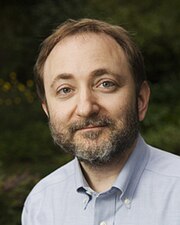Andrew Fire
| Andrew Fire | ||
|---|---|---|
 | ||
| Información personal | ||
| Nacimiento |
27 de abril de 1959 (65 años) Palo Alto (EE. UU.) | |
| Residencia | Stanford | |
| Nacionalidad | estadounidense | |
| Educación | ||
| Educación | doctor en Filosofía | |
| Educado en |
Universidad de California en Berkeley Instituto Tecnológico de Massachusetts | |
| Supervisor doctoral | Phillip Allen Sharp | |
| Información profesional | ||
| Área | Genética | |
| Conocido por | ARN interferente | |
| Empleador |
Universidad Johns Hopkins Universidad Stanford | |
| Afiliaciones | Stanford University Genetics Department y Stanford University Pathology Department | |
| Miembro de | ||
| Sitio web | profiles.stanford.edu/andrew-fire | |
| Distinciones | Premio Nobel de Fisiología o Medicina en 2006 | |
Andrew Zachary Fire (27 de abril de 1959, Palo Alto) es un biólogo estadounidense y profesor de patología y genética en la Facultad de Medicina de la Universidad de Stanford . Fue galardonado con el Premio Nobel de Fisiología o Medicina 2006 , junto con Craig C. Mello , por el descubrimiento de la interferencia de ARN (ARNi). Esta investigación se realizó en la Carnegie Institution de Washington y se publicó en 1998.[1]
Biografía
[editar]Fire nació en Palo Alto, California y creció en Sunnyvale, California. Tras graduarse del Instituto Fremont, fue a la Universidad de California, donde se graduó en matemáticas en 1978, con 19 años. Más tarde, asistió al Massachusetts Institute of Technology (MIT), donde recibió su doctorado en biología en 1983.
Más tarde se trasladó a Cambridge, Reino Unido. Allí fue miembro del Laboratorio de Biología Molecular del Medical Research Council, un grupo liderado por el premio Nobel Sydney Brenner.
Desde 1986 hasta 2003, Fire fue un miembro de la plantilla del departamento de Embriología de la Carnegie Institution of Washington, en Baltimore. También fue profesor de biología en la Universidad Johns Hopkins de la misma ciudad.
Fire es uno de los premiados del Premio Nobel del año 2006 de Fisiología o Medicina, junto a Craig C. Mello, por el descubrimiento de la interferencia ARN. Esta investigación fue llevada a cabo en el Instituto Carnegie de Washington y publicada en 1998. Fire es actualmente profesor de patología y genética en la Escuela de Medicina de la Universidad de Stanford, a la cual entró en 2003.
Premios y honores
[editar]Fire ha recibido los siguientes premios y distinciones:
- Premio Meyenburg en 2002[2]
- Co-receptor (con Craig Mello ) del Premio de la Academia Nacional de Ciencias en Biología Molecular en 2003
- Co-receptor (con Craig Mello, Thomas Tuschl y David Baulcombe ) del Premio Wiley en Ciencias Biomédicas de la Universidad Rockefeller en 2003[3]
- Miembro electo de la Academia Nacional de Ciencias en 2004.[4]
- Co-receptor (con Victor Ambros , Craig Mello y Gary Ruvkun ) de la Universidad de Brandeis Premio Rosenstiel S. Lewis para el Trabajo Distinguido en Investigación Médica en 2004.[5]
- Co-receptor (con Craig Mello) del Premio Internacional de la Fundación Gairdner en 2005[6]
- Co-receptor (con Craig Mello y David Baulcombe ) del Premio Massry en 2005.[7]
- Co-receptor (con Craig Mello) del Premio Paul Ehrlich y Ludwig Darmstaedter en 2006[8]
- Co-receptor (con Craig Mello) del Premio Nobel de Fisiología o Medicina en 2006
Referencias
[editar]- ↑ Fire, Andrew; Xu, SiQun; Montgomery, Mary K.; Kostas, Steven A.; Driver, Samuel E.; Mello, Craig C. (1998-02). «Potent and specific genetic interference by double-stranded RNA in Caenorhabditis elegans». Nature (en inglés) 391 (6669): 806-811. ISSN 1476-4687. doi:10.1038/35888. Consultado el 23 de octubre de 2021.
- ↑ info@meyenburg-stiftung.de, Tobias Oelschläger (2005-04-30T012:00+01:00). «Meyenburg-Stiftung». www.meyenburg-stiftung.de (en alemán). Consultado el 23 de octubre de 2021.
- ↑ «Wiley: Past Winners of the Wiley Prize in Biomedical Sciences». www.wiley.com. Consultado el 23 de octubre de 2021.
- ↑ «The Biology of RNAi». www.nasonline.org. Consultado el 15 de septiembre de 2021.
- ↑ «Past Winners». www.brandeis.edu (en inglés). Consultado el 23 de octubre de 2021.
- ↑ «All Gairdner Awards Laureates». Gairdner Foundation (en inglés estadounidense). Consultado el 15 de septiembre de 2021.
- ↑ christopher. «Past Laureates». Massry Prize (en inglés estadounidense). Consultado el 15 de septiembre de 2021.
- ↑ «Goethe-Universität — Preisträger 2006». www.uni-frankfurt.de. Consultado el 23 de octubre de 2021.
Enlaces externos
[editar]
| Predecesor: Robin Warren Barry Marshall |
2006 |
Sucesor: Mario Capecchi Oliver Smithies Martin Evans |
Text is available under the CC BY-SA 4.0 license; additional terms may apply.
Images, videos and audio are available under their respective licenses.

